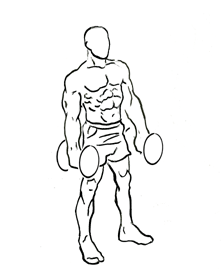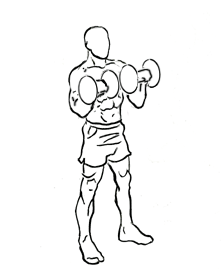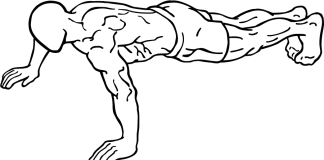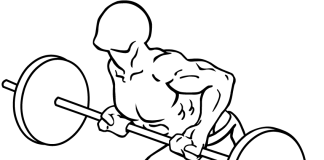Last Updated on September 25, 2014
The Zottman Curl is an advanced dumbbell exercise that combines a traditional bicep curl with a reverse curl, effectively targeting both the biceps and forearms in a single movement. Named after George Zottman, a strongman known for his impressive arm strength, this curl variation is ideal for building well-rounded arm definition and strength. By incorporating a wrist rotation at the top of the movement, the Zottman Curl enhances forearm engagement while still maximizing bicep activation, making it one of the most effective exercises for balanced arm development.
In this guide, we’ll explore the benefits of the Zottman Curl, break down the steps for performing it correctly, discuss common mistakes, and provide tips for incorporating it into your workout routine. Whether you’re a seasoned lifter or looking to add variety to your arm day, mastering the Zottman Curl can help you achieve strong, defined arms.
Why the Zottman Curl is Effective
The Zottman Curl combines two types of curls in one movement: a traditional curl (targeting the biceps) and a reverse curl (targeting the forearms and brachialis). This unique combination provides several benefits:
- Targets Both Biceps and Forearms: The curl-up phase emphasizes the biceps, while the lowering phase engages the forearms, helping to build balanced strength and muscle mass in the arms.
- Improves Grip Strength: The reverse curl portion works the forearm muscles and grip strength, which is essential for heavy lifting and everyday tasks.
- Adds Variety to Arm Training: Incorporating the Zottman Curl prevents workout monotony and can help break through plateaus by challenging the muscles in a different way.
- Promotes Functional Strength: By combining different curl variations, this exercise improves strength and muscle endurance across both the biceps and forearms, enhancing overall arm function.
Anatomy of the Arm Muscles Targeted by the Zottman Curl
Understanding the muscles targeted can help you appreciate the Zottman Curl’s effectiveness:
- Biceps Brachii: The primary muscle worked during the curl-up phase, responsible for flexing the elbow and supinating the forearm.
- Brachialis: Located underneath the biceps, the brachialis assists in elbow flexion and contributes to upper arm thickness.
- Brachioradialis: This forearm muscle is heavily engaged during the lowering (reverse curl) phase, supporting wrist stability and grip strength.
The Zottman Curl not only works these key muscles but also promotes balanced development across the upper and lower portions of the arms.
Step-by-Step Guide to Performing the Zottman Curl
Step 1: Set Up Your Position
- Stand with Proper Posture: Stand with your feet shoulder-width apart, knees slightly bent, and core engaged. This stance provides a stable base for the movement.
- Hold a Dumbbell in Each Hand: Grasp a dumbbell in each hand with a neutral grip (palms facing inward), keeping your arms at your sides and shoulders relaxed.
Step 2: Perform the Curl-Up Phase
- Begin the Curl: Start by curling the dumbbells up towards your shoulders, rotating your palms to face up as you lift. Focus on using your biceps to control the movement.
- Continue the Curl Until Full Contraction: Bring the dumbbells all the way up to your shoulders, squeezing your biceps at the top. Keep your elbows close to your sides to maintain proper form.
Step 3: Rotate for the Reverse Curl
- Rotate Your Wrists at the Top: Once you reach the top of the curl, rotate your wrists so that your palms face downward. This twist shifts the focus to your forearms and prepares you for the reverse curl.
- Pause Briefly: Hold the position for a brief pause, keeping tension on both your biceps and forearms.
Step 4: Perform the Lowering Phase (Reverse Curl)
- Slowly Lower the Dumbbells: With your palms facing down, lower the dumbbells back to the starting position in a controlled motion. Focus on engaging your forearms and avoiding any jerking movements.
- Maintain Control: The descent should be slow and deliberate to maximize muscle engagement in the forearms and brachialis.
Step 5: Repeat
- Continue for Desired Reps: Repeat the movement for the desired number of repetitions, focusing on form and control with each rep. Complete the full range of motion to maximize the benefits.
Tips for Perfecting Your Form
Form is essential in the Zottman Curl to ensure both bicep and forearm activation. Here are some tips to help you perform the exercise safely and effectively:
- Keep Elbows Stationary: Avoid letting your elbows drift forward or outward during the curl. Keeping them close to your body isolates the biceps and prevents swinging.
- Focus on a Slow Descent: The reverse curl phase should be performed slowly to maximize time under tension for the forearms. Avoid letting gravity take over on the way down.
- Engage Your Core: Maintain a stable core to prevent any unnecessary movement in your torso. This also supports proper posture and helps you focus on the arms.
- Use a Moderate Weight: Choose a weight that allows you to control both the curl and the reverse phase. Going too heavy can compromise form, leading to poor activation and potential injury.
Common Mistakes and How to Avoid Them
Avoiding these common mistakes can help you maximize the benefits of the Zottman Curl:
- Using Excessive Weight: Many lifters go too heavy, sacrificing form and reducing muscle activation. Start with a moderate weight to master the movement, then gradually increase as you progress.
- Rushing the Lowering Phase: The lowering phase is crucial for forearm engagement. Lower the dumbbells slowly to ensure maximum forearm activation and prevent strain.
- Swinging the Torso: Avoid using momentum to lift the weights by keeping your core tight and your back straight. Swinging reduces the load on the target muscles and increases injury risk.
- Neglecting the Wrist Rotation: The wrist rotation at the top is key to targeting both the biceps and forearms. Ensure you fully rotate your wrists at the top of each rep to engage both muscle groups effectively.
Variations of the Zottman Curl
Adding variety to the Zottman Curl can challenge your muscles differently and prevent plateaus. Here are some effective variations:
1. Seated Zottman Curl
Perform the Zottman Curl seated to minimize body movement and isolate the arms. This variation is ideal for those who struggle with stability or have a tendency to swing their torso during the movement.
2. Cable Zottman Curl
Using cables instead of dumbbells provides constant tension throughout the movement, challenging the biceps and forearms differently. Attach handles to a low pulley and perform the curl with the same motion as with dumbbells.
3. Single-Arm Zottman Curl
Perform the Zottman Curl with one arm at a time to increase focus and control. This variation allows you to address any strength imbalances between the arms and focus more on each muscle group.
4. Incline Zottman Curl
Lie back on an incline bench to extend the range of motion and place more emphasis on the biceps. The incline increases the stretch on the biceps, enhancing muscle activation and building a fuller arm appearance.
5. Zottman Curl with a Barbell
If you’re experienced with the exercise, you can perform the Zottman Curl with an EZ bar. This variation increases the load on the arms and requires more grip strength, challenging both the biceps and forearms.
Sample Arm Workout Incorporating the Zottman Curl
Here’s a well-rounded arm workout that includes the Zottman Curl to target both the biceps and forearms:
- Warm-Up: 5-10 minutes of light cardio and dynamic stretching for the upper body.
- Zottman Curl: 4 sets of 10-12 reps, focusing on controlled motion and proper wrist rotation.
- Hammer Curl: 3 sets of 10-12 reps to build biceps and forearm strength.
- EZ Bar Curl: 3 sets of 8-10 reps, focusing on overall bicep development.
- Reverse Curl (Barbell or Dumbbell): 3 sets of 12-15 reps to target the brachioradialis and improve grip strength.
- Overhead Tricep Extension: 3 sets of 10-12 reps to complement bicep training and build tricep strength.
- Cool Down: Light stretching for the biceps, forearms, and shoulders to promote flexibility and aid in recovery.
Safety Tips for the Zottman Curl
The Zottman Curl can place stress on the wrists and forearms, so keep these safety tips in mind:
- Warm Up the Wrists and Elbows: Perform wrist and elbow mobility exercises before starting to prepare your joints for the workout.
- Avoid Excessive Weight: Since this exercise involves both a traditional and a reverse curl, choose a weight you can control throughout. Excessive weight can strain your wrists and compromise form.
- Control the Range of Motion: Don’t lower the weights too quickly, as this reduces muscle engagement and increases the risk of injury.
- Stop if You Feel Pain: While some muscle tension is expected, avoid pushing through sharp or uncomfortable pain, especially in the wrists or elbows. Reduce the weight or take a break if needed.
Progressive Overload Techniques for the Zottman Curl
Progressive overload is key to muscle growth and strength. Here’s how to apply it to the Zottman Curl:
- Increase Weight Gradually: Start with a manageable weight and increase it in small increments as you build strength.
- Add Reps: Once you can comfortably complete a set, try adding one or two extra reps to each set for increased endurance.
- Slow Down the Eccentric Phase: Increase time under tension by slowing down the reverse curl phase, aiming for a 3–5 second descent to maximize muscle activation.
- Add Sets: Once you’re comfortable with your routine, increase the number of sets to add volume, promoting muscle growth.
Final Thoughts
The Zottman Curl is a powerful exercise for building balanced arm strength and definition. By combining a traditional bicep curl with a reverse curl, this movement targets both the biceps and forearms, improving grip strength and enhancing arm aesthetics. With its unique twist and focus on controlled movements, the Zottman Curl can help break plateaus and add variety to your arm routine.
Incorporate the Zottman Curl into your workouts, track your progress, and prioritize proper form and control. With consistency and focus, you’ll see significant improvements in arm strength, definition, and overall performance. Embrace this old-school classic to elevate your training and build stronger, more balanced arms.








